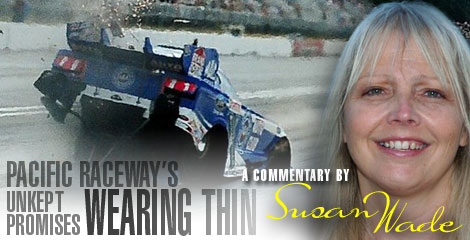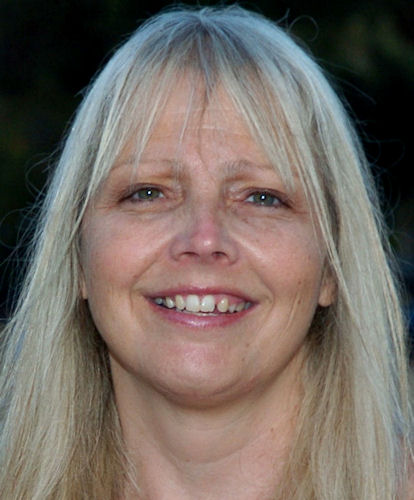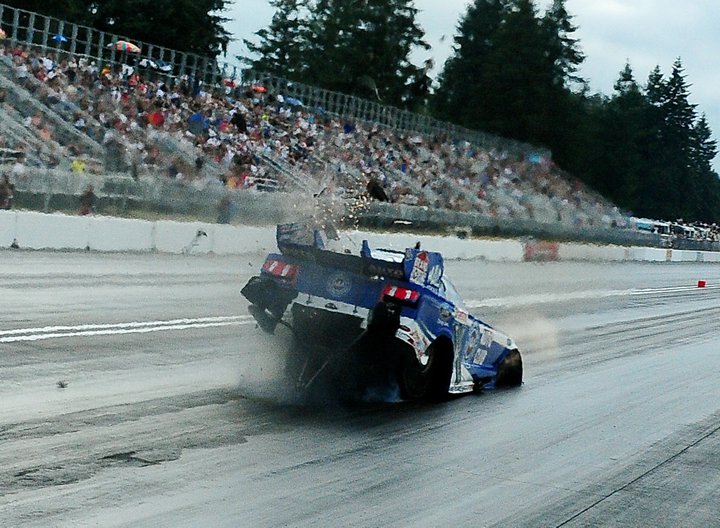PACIFIC RACEWAYS' DECADE OF UNKEPT PROMISES WEARING THIN
Mon, 2011-08-15 20:54
 Funny Car veteran Ron Capps is an old drag-racing soul in a young body. He has joked many times that he was "born too late," for he has an incurable fondness for the glory days of the sport, the days before corporate involvement (as beneficial as it is) dictated the culture.
Funny Car veteran Ron Capps is an old drag-racing soul in a young body. He has joked many times that he was "born too late," for he has an incurable fondness for the glory days of the sport, the days before corporate involvement (as beneficial as it is) dictated the culture.
Just as clearly as he can see the fir trees that ring Pacific Raceways, he almost can see promoter Bill Doner, like Monte Hall on "Let's Make A Deal," bargaining with fans who drove up to the front gate and had no money for admission: "What do you have in your car that we can trade? Anything good in the trunk?" Capps can hear the rock bands playing. He can picture "the free living or whatever you want to call it." Etched in his imagination, thanks to tales from Don Prudhomme and Ace McCulloch, were the crazy burnouts with frenzied fans beating on the cars as they backed up.
"It's when things must have been a lot of fun," Capps, a California native, said. "It's sort of like going to Indy or for me like going to Pomona, where you look around on the ground and say, 'Wow, Jungle Jim probably was pitted here. I love it. I love this part about it."

Seattle is one of his favorite stops on the Full Throttle Drag Racing Series, for it has its own legend, its own free-wheelin' vibe.
Just as clearly as he can see the fir trees that ring Pacific Raceways, he almost can see promoter Bill Doner, like Monte Hall on "Let's Make A Deal," bargaining with fans who drove up to the front gate and had no money for admission: "What do you have in your car that we can trade? Anything good in the trunk?" Capps can hear the rock bands playing. He can picture "the free living or whatever you want to call it." Etched in his imagination, thanks to tales from Don Prudhomme and Ace McCulloch, were the crazy burnouts with frenzied fans beating on the cars as they backed up.
"It's when things must have been a lot of fun," Capps, a California native, said. "It's sort of like going to Indy or for me like going to Pomona, where you look around on the ground and say, 'Wow, Jungle Jim probably was pitted here. I love it. I love this part about it."
Then Capps snapped back to reality -- to the shabby state of the racing surface, to the continued wasted potential, to the appearance that this National Hot Rod Association nation-event venue appears to be no more than a mediocre campground with a dragstrip randomly tossed into the mix.
Another disappointing trip to the Northwest Nationals has trumped a personal vow not to enable the Fiorito family by writing about their Pacific Raceways facility and their false assurances one more time. The plan was not to buy into the useless promises or even rail about their seemingly endless excuses for not keeping them.
But somebody has to speak out until the drivers, pros and sportsmen alike, get a decent track to race on and the media get something besides a dopey mobile home with no view whatsoever of the racetrack from which to work. Bob Wilber, Tim Wilkerson's public-relations representative, correctly pointed out Sunday morning as a group of media gathered around a closed-circuit monitor, "This is crazy. We're 100 feet from the starting line and we have to watch the race on TV." He laughed, and it would have been funny if it weren't so pathetic.
The bulk of the blame goes to the Fioritos for having no more pride than to invite the NHRA and its fans into its substandard, slovenly, dysfunctional home. But the NHRA is at fault in allowing the Fioritos to get by with it year after year.
The NHRA, which has done everything it can do to make a silk purse out of sow's ear of a racing surface there, has been more than patient. Now it needs to get mean or at least get firm.
For too long the NHRA has been the dad who threatens his errant child that he'll spank him if he doesn't obey. Certainly NHRA President Tom Compton is too refined to call his track operator a liar for never making good on a promise to improve Pacific Raceways. The sanctioning body also has tried in good faith to mitigate the ugly potential of the track conditions.
But at some point, the NHRA needs to yank this race from the schedule unless and until the Fioritos spend some of their money to improve the facility. The NHRA should tell the Fioritos that the Western Swing will consist of a Denver-Phoenix-Sonoma triangle until the racing surface and tower -- with adequate room for media members, photographers, and public-relations reps -- have been replaced. (They can visit the Bristol, Gainesville, Sonoma, Charlotte, Pomona, or Joliet venues for hints about how much room that is.)
Then the NHRA needs to mean it. Giving an ultimatum, then backing it up with action serves not so much as punishment for the rudderless, or cheap, Fioritos as it does showing respect for all its racers and fans.
(And if the NHRA has no official set of minimum facility standards, then it needs to adopt one. Minor League Baseball did it about 20 years ago, and facilities across America scrambled to upgrade their ballparks. The concept works.)
The NHRA regards the Pacific Northwest as a highly desirable market. It also relishes, at least privately, the idea that Washington State misguidedly has rebuffed NASCAR's interest three separate times. So the NHRA should have all the reassurance it needs that NASCAR would not swoop in and capture the market in drag racing's absence. NHRA is in the driver's seat to demand the "world-class facility" the Fioritos have been promising since they took back operation of the facility in 2002.
God bless John Force for trying to give the track owners the benefit of the doubt by making apologies for them in a tough economy. However, they've had 10 years to produce and they still have produced nothing. Force should be careful not to become a co-dependent.
He said he couldn't say for sure if the racetrack was to blame for son-in-law Robert Hight's tire explosion during Friday qualifying this year. But considering the scary incidents his daughters have had there -- Ashley Force (Hood) with a wall-banging crash in 2007 and Courtney Force losing a tire there at high speed last year -- Force of all people should be holding the track owners' feet to the fire.
 Besides the fact that these are his loved ones experiencing potentially dangerous situations, he at the least ought to be investigating, if not screaming, about the financial blow this track has dealt his team. He only half-joked after Hight's incident that he'd probably have to win the lottery to recoup the cost of the damage to the Auto Club Mustang body and maybe the chassis. He sent Courtney's alcohol dragster to Murf McKinney's shop in Indiana for a thorough inspection. Ashley's crash took a financial toll, as well. Is that a coincidence that all those problems came at Seattle? Who knows? It would serve Force well to find out.
Besides the fact that these are his loved ones experiencing potentially dangerous situations, he at the least ought to be investigating, if not screaming, about the financial blow this track has dealt his team. He only half-joked after Hight's incident that he'd probably have to win the lottery to recoup the cost of the damage to the Auto Club Mustang body and maybe the chassis. He sent Courtney's alcohol dragster to Murf McKinney's shop in Indiana for a thorough inspection. Ashley's crash took a financial toll, as well. Is that a coincidence that all those problems came at Seattle? Who knows? It would serve Force well to find out.Then again, Force said he doesn't even know the Pacific Raceways owners, didn't even know their names -- he even guessed that he might have met them, thinking "They're the guys in cowboy hats, right?" (The most the Fioritos wear cowboy hats is never.) What makes it worse is that Force, when asked, said he knows all the other track operators.
For much of American business, the rough economy has provided a sometimes-real and sometimes-convenient generic excuse for lack of progress. In the case of Pacific Raceways, the Fioritos have had a decade -- much of it in a healthy economic environment -- to act. Instead, they have blamed former track operator Jim Rockstad, the King County permitting process, environmental impact studies, economic uncertainty, and now, once again, unfriendly neighbors for no upgrades.
Pacific Raceways' latest public-relations ploy is begging fans to inundate King County elected officials with pro-drag-racing emails. The purpose, according to a press release that National Dragster published in its August 5 edition, is "to gain approval of a redevelopment plan that would provide new racing surfaces, increased safety measures, and a new motorsports industrial complex to serve the racing community."
Well, track president Jason Fiorito should put the monkey on the backs where it belongs -- his own. This whole campaign is a red herring. He needs to separate the dragstrip and tower replacement as a project separate from this "master plan" he is pushing.
Frankly, the master plan, as presented in 2009, looks like a win-win situation for the community and Pacific Raceways. Why racetrack neighbors would oppose it is baffling. They would benefit, for example, from a fire station that would cut the current response time by two minutes, as well as a recessed circle track for noise mitigation that includes a community playground atop the rim. Again, though, crusading for a dramatic renovation (most of which has nothing to do with drag racing) doesn't preclude fixing up the existing dragstrip.
So the Fioritos need to stop attaching the dragstrip renovations to the master plan. NHRA racers shouldn’t have to wait for the county to approve a circle track or fire station or any other snazzy additions. Drag racers come to Pacific Raceways right now, and they expect and deserve to have a safe race course. That is something the Fioritos can do right now.
Although the Pacific Raceways and Fiorito family coffers are private, it is safe to say that the company has enough money to make the changes to the dragstrip and tower. Surely the third runway project at Seattle-Tacoma International Airport -- which used tons and tons of gravel excavated from Pacific Raceways and was completed in 2008 -- is not the only income source for the company. That project alone, which Jason Fiorito has said many times would fund upgrades to the dragstrip, was worth (by several estimates) a little more than $2 million.
Ron Capps always has respected Pacific Raceways for its rich history and colorful lore and has been extremely careful, even during other drivers' popular track-bashing moments, to say he appreciates its idiosyncrasies. But now even he felt it was time to take a stand.
"I love it," Capps said with all the diplomacy he could muster, framed by his love of those days gone by. "Now, you look at the other side of it. There's stuff that hasn't been fixed up. You have to look at that, because now we're going twice as fast as they did back then. And that part of you really wants to see improvements or have the place fixed up more."
Capps was being nice. This commentary is not. Fioritos, fix the place up. NHRA, make them -- make them -- do it. And the next time you folks invite us to your house, serve us something better than a big stack of boloney.
| {loadposition feedback} |
Categories:




































